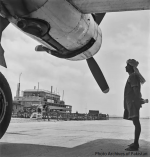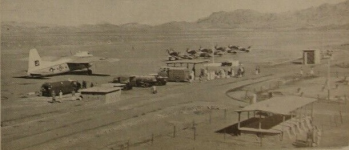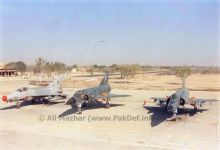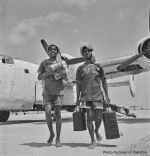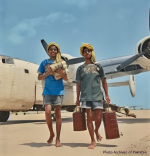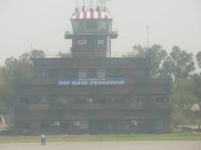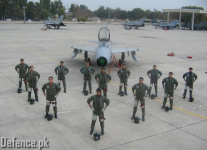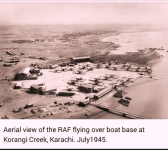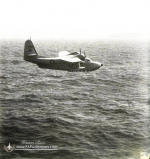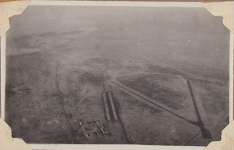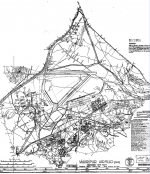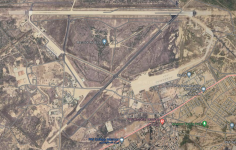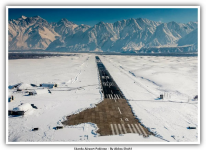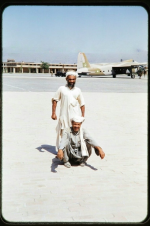- Jan 25, 2024
- 111,083
- 353
PAF Base Masroor
PAF Masroor, the largest and one of the premier air bases of the Pakistan Air Force derived its original name - Mauripur - from a small village near this coastal airfield. It was established during WW II in 1940-41 as a temporary staging post and air transport base for the US Air Corps;the facilities of the staging post were extensively utilized by the Allies. By 1945, the Royal Air Force had taken over the base as a strategic link for India and the Far East. After the creation of Pakistan, the RAF remained a joint user of Mauripur together with the RPAF upto 1955; a transit camp was set up to handle all movement of RAF personnel to and from Pakistan.
The RPAF Station Mauripur was established on 1st January 1948 with Wing Commander Zaheer Ahmed as the station commander. In 1948, about a year after the birth of the Royal Pakistan Air Force, Air Headquarters moved from Peshawar to Mauripur. Thus in the early days of the RPAF, Mauripur contributed significantly in giving shape to the newly born air force.
Its primary role was to administer No.6 Transport Squadron. All the officers and men, were veterans of WW II and their rich experience helped to evolve sound flying practices, high standards of maintenance and good traditions with regard to customs of service and social life in the messes.
For the first two decades Mauripur remained the nucleus of advance flying training as well as an operational base and an administrative center. The station had the proud distinction of receiving Quaid-e-Azam Muhammad Ali Jinnah on 13th August 1947. On 11th September, the
last journey of the father of the nation from Quetta to his eternal abode also staged through Mauripur.
In 1967, Air Commodore Masroor Hosain, a brilliant officer of the PAF who was then the base commander of Mauripur, was killed in a tragic bird strike accident during an operational exercise, in a B-57 he was flying in the vicinity of Karachi: subsequently the base was named after him.
In one of its early roles, Mauripur was required to provide air support and protection to the Pakistan Navy, by undertaking coastal surveillance in SA-16 Albatross aircraft.
The proximity of the base to the Karachi port and to important sea routes of the Arabian sea makes it, strategically, a very important base. It is entrusted with the air defence of the southern air space of Pakistan. The base provides air protection and support to Pakistan Army and, in conjunction with Pakistan Navy, it defends the coastal areas of Pakistan. It also has a number of satellite bases in Baluchistan and Sind.
In December 45, a Royal Indian Air Force Dakota of No 12 Squadron was positioned at Mauripur and by March 46 the entire squadron had been shifted to this base. In 1947, No 6 Squadron of the RPAF was formed at Mauripur with several additional Dakotas fresh from overhaul at the Hindustan Aeronautical Factory in Bangalore. No 6 Squadron carried out intensive missions in support of own troops in Kashmir and the northern areas in 1948 and 49.
The modern era of PAF Base Masroor, as a multipurpose fighter base, started with the establishment of No. 32 Fighter Ground Attack Wing in August 56, equipped with F-86 jet fighters. In 1960, Nos 7 and 8 Squadrons constituting 31 Wing were formed with American B-57 light bomber aircraft. This aircraft is still being operated from PAF Base Masroor along with a number of other combat aircraft.
The maintenance wing of the base had the unique privilege of servicing the Vickers Viking aircraft of the Quaid-e-Azam after independence. Since then, the base has grown steadily in man-power and size and also in its ability to absorb new systems and technology. In 1956, with the induction of American weapon systems, technical know-how started to develop for modern aircraft like F-86, T-33 and B-57. Over the
years a wide range of facilities were installed including jet engine, aircraft structural
and radar shops.
Masroor also house's a number of important lodger units such as the Central Medical Board, Aero-Medical Institute, Institute of Flight Safety, Office of the Deputy Controller of Accounts Air Force, PAF Press and Air Tactical Support School.
During the 65 and 71 wars, the squadrons from this base fought with exemplary determination and the pilots displayed outstanding courage and leadership. Mauripur has also had the honor of winning the highest gallantry award, the Nishan-e-Haider, posthumously conferred on Pilot Officer Rashid Minhas in 1971.
Three of Masroor’s base commanders Group Captains Nur Khan and Rahim Khan and Air Commodore Anwar Shamim rose to the command of the PAF. Two other
Chiefs, Air Marshal Zafar Chaudhry and Air Chief Marshal ZuIfiqar Ali Khan were
officers commanding of 32 Fighter Ground Attack Wing located at the base. Upon
the creation of Pakistan, Mauripur with its sprawling complex was a veritable
thorough-fare. A refugee colony existed within the camp area.
The USAF's Military Air Transport Services used to make regular stops here. A missionary school was functioning here since the early 40s; the present PAF Intermediate College now stands at the same site. There was no barbed wire along the perimeter of the base. In course of time, all these security hazards had been removed one by one and before the 65 war the premises of the base had been made fully secure.
With concerted efforts by all concerned, the social life at Masroor has been so organized over the years as to make the base a small, well equipped, and self supporting town.
The Markaz-e-Mujahidda run by the Masroor branch of PAFWA renders valuable services to the families of air-men. Several sports fields, a nine-hole golf course and a gymnasium with modern facilities help to keep its men fit. A PAF Intermediate College and 5 secondary and primary schools established by the Government of Sind cater to the educational requirements of the children of PAF personnel and civilians from the adjoining areas. There are 12 mosques in various camps, out of which 2 are newly constructed and have all the modern amenities.
PAF Base Masroor, by virtue of its strategic location, will always play a vital role in the air defence of southern and coastal regions of Pakistan. The base has the necessary infrastructure for the deployment and operation of any modern weapon system and the potentialities of growth and development to meet any future requirements.
PAF Masroor, the largest and one of the premier air bases of the Pakistan Air Force derived its original name - Mauripur - from a small village near this coastal airfield. It was established during WW II in 1940-41 as a temporary staging post and air transport base for the US Air Corps;the facilities of the staging post were extensively utilized by the Allies. By 1945, the Royal Air Force had taken over the base as a strategic link for India and the Far East. After the creation of Pakistan, the RAF remained a joint user of Mauripur together with the RPAF upto 1955; a transit camp was set up to handle all movement of RAF personnel to and from Pakistan.
The RPAF Station Mauripur was established on 1st January 1948 with Wing Commander Zaheer Ahmed as the station commander. In 1948, about a year after the birth of the Royal Pakistan Air Force, Air Headquarters moved from Peshawar to Mauripur. Thus in the early days of the RPAF, Mauripur contributed significantly in giving shape to the newly born air force.
Its primary role was to administer No.6 Transport Squadron. All the officers and men, were veterans of WW II and their rich experience helped to evolve sound flying practices, high standards of maintenance and good traditions with regard to customs of service and social life in the messes.
For the first two decades Mauripur remained the nucleus of advance flying training as well as an operational base and an administrative center. The station had the proud distinction of receiving Quaid-e-Azam Muhammad Ali Jinnah on 13th August 1947. On 11th September, the
last journey of the father of the nation from Quetta to his eternal abode also staged through Mauripur.
In 1967, Air Commodore Masroor Hosain, a brilliant officer of the PAF who was then the base commander of Mauripur, was killed in a tragic bird strike accident during an operational exercise, in a B-57 he was flying in the vicinity of Karachi: subsequently the base was named after him.
In one of its early roles, Mauripur was required to provide air support and protection to the Pakistan Navy, by undertaking coastal surveillance in SA-16 Albatross aircraft.
The proximity of the base to the Karachi port and to important sea routes of the Arabian sea makes it, strategically, a very important base. It is entrusted with the air defence of the southern air space of Pakistan. The base provides air protection and support to Pakistan Army and, in conjunction with Pakistan Navy, it defends the coastal areas of Pakistan. It also has a number of satellite bases in Baluchistan and Sind.
In December 45, a Royal Indian Air Force Dakota of No 12 Squadron was positioned at Mauripur and by March 46 the entire squadron had been shifted to this base. In 1947, No 6 Squadron of the RPAF was formed at Mauripur with several additional Dakotas fresh from overhaul at the Hindustan Aeronautical Factory in Bangalore. No 6 Squadron carried out intensive missions in support of own troops in Kashmir and the northern areas in 1948 and 49.
The modern era of PAF Base Masroor, as a multipurpose fighter base, started with the establishment of No. 32 Fighter Ground Attack Wing in August 56, equipped with F-86 jet fighters. In 1960, Nos 7 and 8 Squadrons constituting 31 Wing were formed with American B-57 light bomber aircraft. This aircraft is still being operated from PAF Base Masroor along with a number of other combat aircraft.
The maintenance wing of the base had the unique privilege of servicing the Vickers Viking aircraft of the Quaid-e-Azam after independence. Since then, the base has grown steadily in man-power and size and also in its ability to absorb new systems and technology. In 1956, with the induction of American weapon systems, technical know-how started to develop for modern aircraft like F-86, T-33 and B-57. Over the
years a wide range of facilities were installed including jet engine, aircraft structural
and radar shops.
Masroor also house's a number of important lodger units such as the Central Medical Board, Aero-Medical Institute, Institute of Flight Safety, Office of the Deputy Controller of Accounts Air Force, PAF Press and Air Tactical Support School.
During the 65 and 71 wars, the squadrons from this base fought with exemplary determination and the pilots displayed outstanding courage and leadership. Mauripur has also had the honor of winning the highest gallantry award, the Nishan-e-Haider, posthumously conferred on Pilot Officer Rashid Minhas in 1971.
Three of Masroor’s base commanders Group Captains Nur Khan and Rahim Khan and Air Commodore Anwar Shamim rose to the command of the PAF. Two other
Chiefs, Air Marshal Zafar Chaudhry and Air Chief Marshal ZuIfiqar Ali Khan were
officers commanding of 32 Fighter Ground Attack Wing located at the base. Upon
the creation of Pakistan, Mauripur with its sprawling complex was a veritable
thorough-fare. A refugee colony existed within the camp area.
The USAF's Military Air Transport Services used to make regular stops here. A missionary school was functioning here since the early 40s; the present PAF Intermediate College now stands at the same site. There was no barbed wire along the perimeter of the base. In course of time, all these security hazards had been removed one by one and before the 65 war the premises of the base had been made fully secure.
With concerted efforts by all concerned, the social life at Masroor has been so organized over the years as to make the base a small, well equipped, and self supporting town.
The Markaz-e-Mujahidda run by the Masroor branch of PAFWA renders valuable services to the families of air-men. Several sports fields, a nine-hole golf course and a gymnasium with modern facilities help to keep its men fit. A PAF Intermediate College and 5 secondary and primary schools established by the Government of Sind cater to the educational requirements of the children of PAF personnel and civilians from the adjoining areas. There are 12 mosques in various camps, out of which 2 are newly constructed and have all the modern amenities.
PAF Base Masroor, by virtue of its strategic location, will always play a vital role in the air defence of southern and coastal regions of Pakistan. The base has the necessary infrastructure for the deployment and operation of any modern weapon system and the potentialities of growth and development to meet any future requirements.
Source: https://www.PKDefense.com


